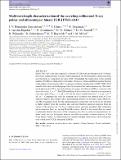Files in this item
Multiwavelength characterization of the accreting millisecond X-ray pulsar and ultracompact binary IGR J17062-6143
Item metadata
| dc.contributor.author | Hernández Santisteban, J. V. | |
| dc.contributor.author | Cúneo, V. | |
| dc.contributor.author | Degenaar, N. | |
| dc.contributor.author | van den Eijnden, J. | |
| dc.contributor.author | Altamirano, D. | |
| dc.contributor.author | Gómez, M. N. | |
| dc.contributor.author | Russell, D. M. | |
| dc.contributor.author | Wijnands, R. | |
| dc.contributor.author | Golovakova, R. | |
| dc.contributor.author | Reynolds, M. T. | |
| dc.contributor.author | Miller, J. M. | |
| dc.date.accessioned | 2019-09-11T11:30:05Z | |
| dc.date.available | 2019-09-11T11:30:05Z | |
| dc.date.issued | 2019-10 | |
| dc.identifier | 261032461 | |
| dc.identifier | 6fa97d2b-6836-4cf7-9663-85ce7425d9fb | |
| dc.identifier | 000484349700013 | |
| dc.identifier | 85081649452 | |
| dc.identifier.citation | Hernández Santisteban , J V , Cúneo , V , Degenaar , N , van den Eijnden , J , Altamirano , D , Gómez , M N , Russell , D M , Wijnands , R , Golovakova , R , Reynolds , M T & Miller , J M 2019 , ' Multiwavelength characterization of the accreting millisecond X-ray pulsar and ultracompact binary IGR J17062-6143 ' , Monthly Notices of the Royal Astronomical Society , vol. 488 , no. 4 , pp. 4596-4606 . https://doi.org/10.1093/mnras/stz1997 | en |
| dc.identifier.issn | 0035-8711 | |
| dc.identifier.other | BibCode: 2019MNRAS.488.4596H | |
| dc.identifier.other | ORCID: /0000-0002-6733-5556/work/61370238 | |
| dc.identifier.uri | https://hdl.handle.net/10023/18461 | |
| dc.description.abstract | IGR J17062–6143 is an ultracompact X-ray binary (UCXB) with an orbital period of 37.96 min. It harbours a millisecond X-ray pulsar that is spinning at 163 Hz and and has continuously been accreting from its companion star since 2006. Determining the composition of the accreted matter in UCXBs is of high interest for studies of binary evolution and thermonuclear burning on the surface of neutron stars. Here, we present a multiwavelength study of IGR J17062–6143 aimed to determine the detailed properties of its accretion disc and companion star. The multi-epoch photometric UV to near-infrared spectral energy distribution (SED) is consistent with an accretion disc Fν ∝ ν1/3. The SED modelling of the accretion disc allowed us to estimate an outer disc radius of Rout=2.2+0.9−0.4×1010 cm and a mass-transfer rate of m˙=1.8+1.8−0.5×10−10 M⊙ yr−1. Comparing this with the estimated mass-accretion rate inferred from its X-ray emission suggests that ≳90 per cent of the transferred mass is lost from the system. Moreover, our SED modelling shows that the thermal emission component seen in the X-ray spectrum is highly unlikely from the accretion disc and must therefore represent emission from the surface of the neutron star. Our low-resolution optical spectrum revealed a blue continuum and no emission lines, i.e. lacking H and He features. Based on the current data we cannot conclusively identify the nature of the companion star, but we make recommendations for future study that can distinguish between the different possible evolution histories of this X-ray binary. Finally, we demonstrate how multiwavelength observations can be effectively used to find more UCXBs among the LMXBs. | |
| dc.format.extent | 3102071 | |
| dc.language.iso | eng | |
| dc.relation.ispartof | Monthly Notices of the Royal Astronomical Society | en |
| dc.subject | Accretion | en |
| dc.subject | Accretion discs | en |
| dc.subject | Stars: neutron | en |
| dc.subject | X-rays: binaries | en |
| dc.subject | X-rays: individual: IGR J17062-6143 | en |
| dc.subject | QB Astronomy | en |
| dc.subject | QC Physics | en |
| dc.subject | DAS | en |
| dc.subject.lcc | QB | en |
| dc.subject.lcc | QC | en |
| dc.title | Multiwavelength characterization of the accreting millisecond X-ray pulsar and ultracompact binary IGR J17062-6143 | en |
| dc.type | Journal article | en |
| dc.contributor.institution | University of St Andrews. School of Physics and Astronomy | en |
| dc.identifier.doi | 10.1093/mnras/stz1997 | |
| dc.description.status | Peer reviewed | en |
| dc.identifier.url | http://adsabs.harvard.edu/abs/2019MNRAS.488.4596H | en |
This item appears in the following Collection(s)
Items in the St Andrews Research Repository are protected by copyright, with all rights reserved, unless otherwise indicated.

